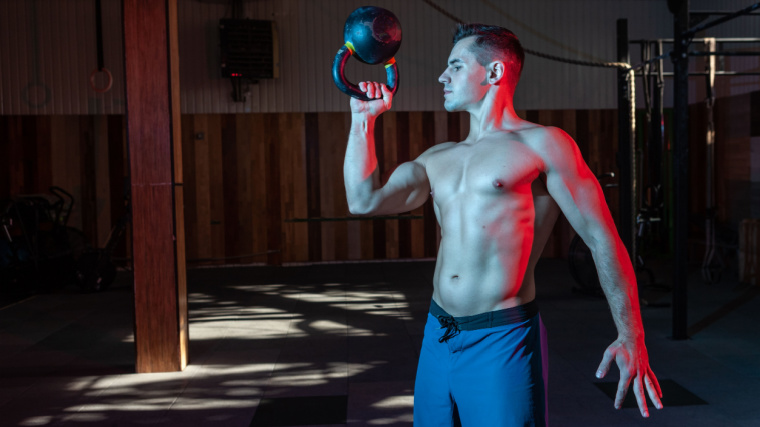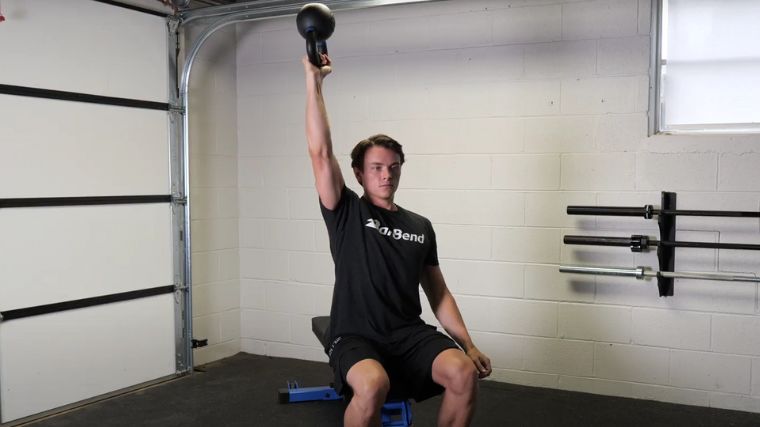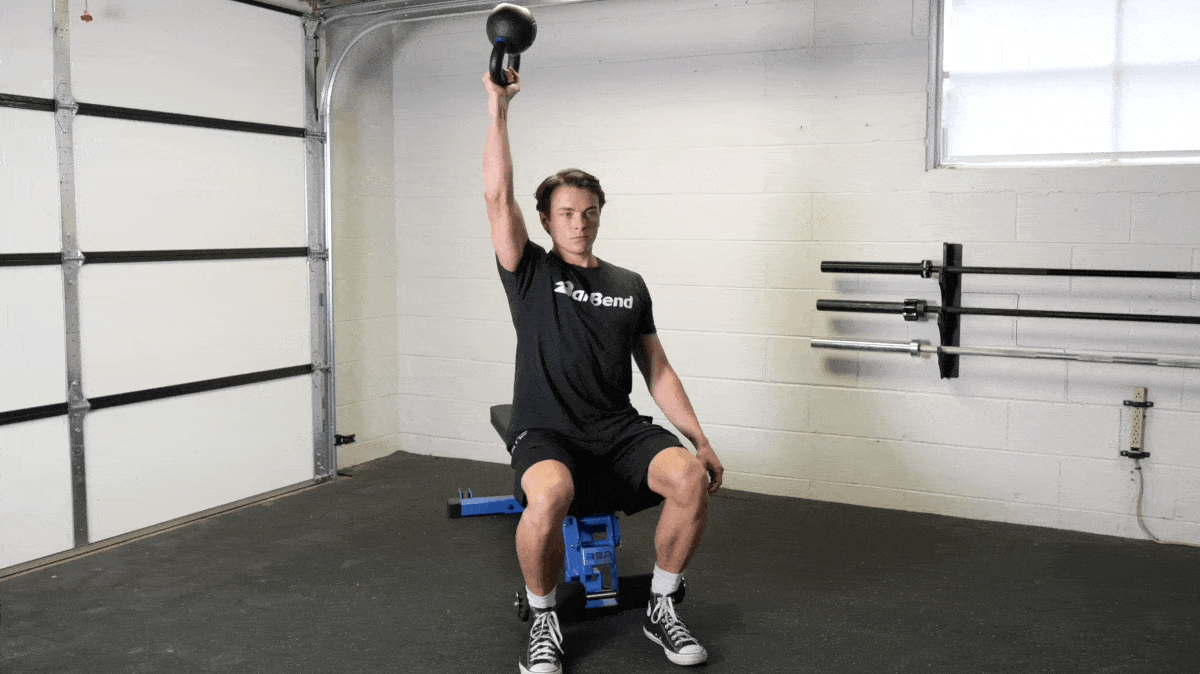Whether you’re a kettlebell aficionado or you’re new to the club, you probably spend most of your time holding a kettlebell the way you pick it up — with the handle in your hands and the bottom of the bell facing the ground. But what happens when you flip it so that your hand is under the bell with its bottom facing the ceiling?
Here’s where you’ll find an exercise that’s not only a great warm-up, but a fantastic way to improve your shoulder, grip, core, and overall upper body strength and stability. It may not be the first thing that comes to your mind when you think of kettlebells, but you’re in for a pleasant surprise with the bottoms-up kettlebell press.
Holding the kettlebell essentially upside down forces you to stabilize your lifts like never before. And now, you’re going to learn everything you need to know about how to do it. Read on to learn how to improve grip strength, shoulder strength, and stability, all at once.
Editor’s Note: The content on BarBend is meant to be informative in nature, but it should not be taken as medical advice. When starting a new training regimen and/or diet, it is always a good idea to consult with a trusted medical professional. We are not a medical resource. The opinions and articles on this site are not intended for use as diagnosis, prevention, and/or treatment of health problems. They are not substitutes for consulting a qualified medical professional.
- How to Do the Bottoms-Up Kettlebell Press
- Bottoms-Up Kettlebell Press Variations
- Bottoms-Up Kettlebell Press Alternatives
- Benefits of the Bottoms-Up Kettlebell Press
- Bottoms-Up Kettlebell Press Sets and Reps
- Muscle Worked by the Bottoms-Up Kettlebell Press
- Who Should Do the Bottoms-Up Kettlebell Press
- Common Bottoms-Up Kettlebell Press Mistakes
- Frequently Asked Questions
How to Do the Bottoms-Up Kettlebell Press
You may not always have access to heavier bells — but you can still level up your training and see yourself improving with accessories like the bottoms-up kettlebell press. Here are the steps to this press variation. All you need is a light-to-moderate-weight bell.
[Read More: 5 At-Home Workouts for Strength, Muscle Growth, Power, and More]
- Step 1 — Set your feet a little wider than shoulder-width apart.
- Step 2 — Pick up the kettlebell by the handle. Use your opposite hand to hold the bell on the base while squeezing the center of the handle with a tight grip.
- Step 3 — Like a biceps curl, bring the kettlebell up to be stacked with your forearm. Your elbow should be outside of your ribcage but slightly in front of your torso.
- Step 4 — Bring in enough tension to tighten up your whole body from your feet to the bell. The bell should be balanced and held deep in your palm, grip tight.
- Step 5 — Push the kettlebell toward the ceiling without loosening your grip. It should look like there’s a string on the base pulling it straight up until it’s directly over your shoulder with your arm straight, elbow locked.
- Step 6 — Slowly descend by pulling your elbow down towards your ribcage with your forearm vertical. Continuously squeeze the kettlebell handle, don’t quit.
Coach’s Tip: For beginners, try to hold the handle on the corner closest to the thumb side. You may find it easier to get balanced.
Bottoms-Up Kettlebell Press Variations
Want more variety? These exercise cousins of the bottoms-up kettlebell press are solid options whether you’re working on your shoulder mobility, recovering from an injury, or looking for more ways to explore balance, coordination, and grip.
Half-Kneeling Bottoms-Up Press
[Read More: The 8 Best Knee Sleeves You Can Buy]
- Set up in a lunge position. Bend your legs at 90 degrees, one in front and one behind you.
- Instead of your feet being hip distance apart try to imagine you are kneeling on a tightrope.
- Start the press on the side with your knee forward.
- Complete your reps, then switch sides.
Bottoms-Up Hold
[Read More: The 15 Best Shoulder Exercises For Building Muscle]
- Bring the kettlebell into the bottoms-up position, stacked over your forearm.
- Squeeze the handle for a secure grip, then tighten up your whole body by rooting your feet through the ground and irradiating tension.
- Constantly hold the kettlebell with the tightest grip possible.
- As soon as you lose balance, relax, shake it off, and reset.
Bottoms-Up Floor Press
[Read More: 5 Bench Press Programs to Build a Bigger, Stronger Chest]
- Lie on your back and place one kettlebell beside you on the outside of your torso, aligned with the bottom of your ribcage.
- Roll to the side toward the kettlebell and place the handle securely in your palm.
- Roll back on your back and use your opposite hand to assist the kettlebell into the bottoms-up position. Your arm should be bent 90 degrees with your elbow close to your ribcage.
- With a tight grip on the handle, press the bell straight up until it is stacked over a straight arm with a locked-out elbow.
- Pull your elbow back down to your ribcage to descend.
- Complete your reps, then switch sides.
Bottoms-Up Kettlebell Press Alternatives
Everybody needs to start somewhere. The grip requirements and stabilization for the full bottoms-up kettlebell press may not be accessible to you at this time.
Here, you’ll find a few alternative movements that are just as joint-friendly and will encourage you to keep practicing until the full bottoms-up versions are ready to roll.
Bottoms-Up Goblet Press
- Place your hands on the kettlebell horns with the base of the kettlebell pointed up. Your hands should be touching the bell and the base flat enough to rest a plate on it.
- While standing with your feet hip-distance apart (or slightly wider for your comfort), tighten your whole body while you press the bell up over your head. You should not see the bell in front of you when your arms are extended.
- Bring the bell back down by bending your elbows and pulling them towards your sides. Repeat for reps.
Waiters Press
[Read More: What Are Workout Splits and Which Is the Best One?]
- Hold the kettlebell by the center of the handle, bottoms up, and rest the bell on its side in the palm of the opposite hand.
- Aim to look like you are trying to balance the bell like a tray on one hand. Position the other arm across your body at a 45-degree angle.
- Focusing on the bell side, press the bell towards the sky, then bring it back down.
- Repeat for reps, then switch sides.
Strict Press
[Read More: Get Freakishly Strong With the 5×5 Workout Program]
- Bring the kettlebell safely to the rack position with your wrist completely straight, forming a straight line with your forearm.
- Create tension throughout your body, engage your core, tighten your quads, and squeeze your glutes.
- Inhale, then on an exhale press like you’re going to punch through the ceiling.
- Finish the press with your arm fully extended and locked out vertically.
- Repeat for reps, then switch sides.
Benefits of the Bottoms-Up Kettlebell Press
Sport-related shoulder injuries are relatively common. Increasing your strength, stability, and mobility is one tool for reducing the likelihood of shoulder injury. (2) The bottoms-up kettlebell press offers several ways to improve shoulder mobility, shoulder stability, and core stability.
Shoulder Stability
By pressing the kettlebell from a bottom-up position, you activate and strengthen the stabilizing muscles in the shoulder girdle. This helps prevent unwanted movements or imbalances during the press, ultimately enhancing overall shoulder stability.
Core Stability
The bottoms-up kettlebell press is very unstable. Though this isn’t a core exercise, your core muscles have to work quite hard to stabilize your spine and pelvis. That ensures proper alignment and support throughout the movement. This activation of the core contributes to improved core stability and a more controlled and efficient press.
Shoulder Mobility
You need a greater range of motion and mobility in your shoulder joint with a bottoms-up press. The press finishes in a full extension of your arm, promoting increased mobility in the shoulder. Over time, this can help in enhancing your shoulder’s range of motion and flexibility.
Bottoms-Up Kettlebell Press Sets and Reps
A little goes a long way with this lift. Too many reps, too heavy kettlebells, and moving too quickly will fry your gains fast. Here are the two primary approaches if you want to start incorporating these presses regularly:
- For Movement Prep or Warm Up: Do two to three sets of two to three repetitions. Perform reps on both sides and take your time between sets to activate rather than fatigue your muscles.
- For Strength: Perform three to four sets of six to eight repetitions. Add the bottoms-up clean to your press to push your grip work even further. Use a weight that challenges you but is much lighter than you would use for more stable upper-body kettlebell exercises.
Muscles Worked by the Bottoms-Up Kettlebell Press
The bottoms-up kettlebell press is a challenging exercise that engages various muscle groups so you can stabilize and execute the movement effectively. Here’s a breakdown of the primary muscles involved:
Deltoids
The deltoids play a central role in the kettlebell press. The anterior deltoid (front), lateral deltoid (side), and posterior deltoid (rear) will all play a role here, with your front delts shouldering much of the burden. These muscles are responsible for your press, aiding in lifting the kettlebell from the rack to overhead.
Rotator Cuffs
The rotator cuff muscles, including the supraspinatus, infraspinatus, teres minor, and subscapularis, have a critical role in stabilizing the shoulder joint throughout the press, enhancing shoulder stability, and helping prevent potential injury.
Forearms
The muscles in the forearms and hands, including the flexor muscles and intrinsic hand muscles, work very hard to maintain a secure grip on the kettlebell in the bottoms-up position.
Abdominal Muscles
The entire core musculature is engaged to stabilize the spine, pelvis, and torso during the bottoms-up kettlebell press. This includes the rectus abdominis, obliques, transverse abdominis, and erector spinae muscles.
Who Should Do the Bottoms-Up Kettlebell Press
If you are pressing bottoms-up, you will likely notice improvements in your pressing overall. Why? The bottoms-up press is a self-correcting drill that allows you to find your weak links and address them.
You have to work hard to stabilize the bell’s center of mass. That stabilization helps create body awareness and increase the strength that you need for activities of daily living and tearing up the lifting platform.
Athletes Recovering From Injury
Whether you’re training through injury or managing injury risk, consult a doctor or physical therapist to ensure that you’re able to safely lift. Then, gravitate toward exercises that encourage proper joint alignment and mechanics like the bottoms-up kettlebell press.
[Read More: Omega 3 Benefits — More Muscle, Better Recovery, and Enhanced Endurance]
With a much lighter kettlebell, you can get stronger and work on the smaller deeper muscles that stabilize the shoulder joint.
Everyday Athletes
Enjoy a good hike with your friends? Maybe you love swimming at the pool with your grandkids. If you like those kinds of activities, then you are an everyday athlete. This lift will come in especially handy for you.

As you do the bottoms-up kettlebell press, you’ll notice the similarity in body position to lifting a heavy object overhead. This lift can help to improve your shoulder and core stability for fewer injuries and more endurance to do the things you love.
Strength and Power Athletes
For strength and power athletes, isometric holds before dynamic contraction can help to improve your performance as a strength and power athlete. (1) If you are into big bench press numbers, the bottoms-up press is your secret weapon.
Your lats are the key. Learning to stabilize your lats in the bottoms-up position will lend itself to better shoulder stabilization and lat recruitment for multiple exercises, from the overhead press to the deadlift.
Common Bottoms-Up Kettlebell Press Mistakes
A kettlebell is already an unstable weight by design. When inverted, it only gets trickier. Here are some common errors to avoid when getting started.
Starting Too Heavy
This movement is not to be underestimated. The average athlete has to work very hard to press the same amount of weight bottoms-up that they can normally strict press. Start very light and work your way up slowly.
Moving Too Quickly
That little dance you do to try to balance the kettlebell is all part of the gains. If you shoot the kettlebell up and down too quickly, you negate the benefits of stabilization throughout the movement.
Starting With a Dip
Trying to use momentum like you would for a push press is not improving the lift. You’re adding speed in a scenario where slow intentional movement is the key to your results. Instead of starting the movement with a dip, you want to start with your body tight and grip strong.
Flip Your Lift
If you’re serious about shoulder stability and mobility, this is a move that deserves to be a permanent fixture in your toolkit. Incorporating the bottoms-up kettlebell press into your training routine can be a valuable addition for improving shoulder and core stability, and enhancing shoulder mobility.
Remember to start light and gradually progress to heavier weights to maximize the benefits while ensuring safety and proper form. Who knew that holding a kettlebell upside down could be so challenging and so rewarding?
FAQs
Here are a few of the common questions asked when starting to incorporate bottoms-up training.
Where should I start my bottoms-up training?
Start with one kettlebell and just hold it bottoms-up isometrically, working your way up to a 30-second hold. Try to master that before you move on to marching on the spot and then walking with the hold. The stabilization training will translate to your other lifts and functional strength.
Will this hurt my hands?
This move is not bad for your hands, but it will be taxing on them. Grip training is one area where calluses are friend and foe. You don’t want your calluses too thick or for there to be any rips or tears in your hands. Your hand will develop thicker skin which will benefit your overall training making your hands more resilient.
What do I do if the kettlebell keeps falling?
The instability of the kettlebell makes balance a huge part of the challenge. If you can’t maintain its position, start by going down in weight. Training in a space with durable floors, pillows, or cushions can help if a kettlebell falls. To reduce the likelihood of injury let the kettlebell fall, and be ready to bail when needed. Make sure to let it drop away from your feet.
References
- Lum D, Barbosa TM. Brief Review: Effects of Isometric Strength Training on Strength and Dynamic Performance. Int J Sports Med. 2019 May;40(6):363-375.
- Cools AM, Maenhout AG, Vanderstukken F, Declève P, Johansson FR, Borms D. The challenge of the sporting shoulder: From injury prevention through sport-specific rehabilitation toward return to play. Ann Phys Rehabil Med. 2021 Jul;64(4):101384.
The post How to Do the Bottoms-Up Kettlebell Press for Shoulder Stability and Strength appeared first on BarBend.


